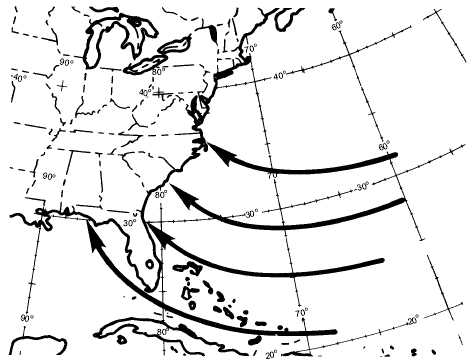Maritime Tropical (mT) Air Atlantic in Summer
The weather in the eastern half of the United States
is dominated by mT air in summer (fig. 4-17). As in
winter, warmth and high moisture content characterize
this air. In summer, convective instability extends to
higher levels; there is also a tendency toward increasing
instability when the air moves over a warmer landmass.
(See fig. 4-18.) This is contrary to winter conditions.
Along the coastal area of the southern states, the
development of stratocumulus clouds during the early
morning is typical. These clouds tend to dissipate
during the middle of the morning and immediately
reform in the shape of scattered cumulus. The
continued development of these clouds leads to
scattered showers and thunderstorms during the late
afternoon. Ceilings in the stratocumulus clouds are
generally favorable (700 to 1,500 feet) for the operation
of aircraft. Ceilings become unlimited with the
development of the cumulus clouds. Flying conditions
are generally favorable despite the shower and
thunderstorm conditions, since the convective activity
is scattered and can be circumnavigated. Visibility is
usually good except near sunrise when the air is
relatively stable over land.
When mT air moves slowly northward over the
continent, ground fogs frequently form at night. Sea
fogs develop whenever this air flows over a relatively
cold current such as that occurring off the east coast.
The
notorious
fogs
over
the
Grand
Banks
of
Newfoundland are usually formed by this process.
In late summer, the Bermuda high intensifies at
times and seems to retrograde westward. This results in
a general flow of mT air over Texas, New Mexico,
Arizona, Utah, Colorado, and even southern California.
The mT air reaching these areas is very unstable
because of the intense surface heating and orographic
lifting it undergoes after leaving the source region in the
Caribbean
and
Gulf
of
Mexico.
Shower
and
thunderstorm conditions, frequently of cloudburst
intensity, then prevail over the southwestern states.
Locally this condition is termed sonora weather.
4-15
AG5f0417
mT
Figure 4-17.—Maritime tropical (mT) air, Atlantic, in summer.
WARM OCEAN
WARMER CONTINENT
AG5f0418
Figure 4-18.—mT (Gulf of Mexico or Atlantic) air in summer
moving northward over a warm continental surface.




